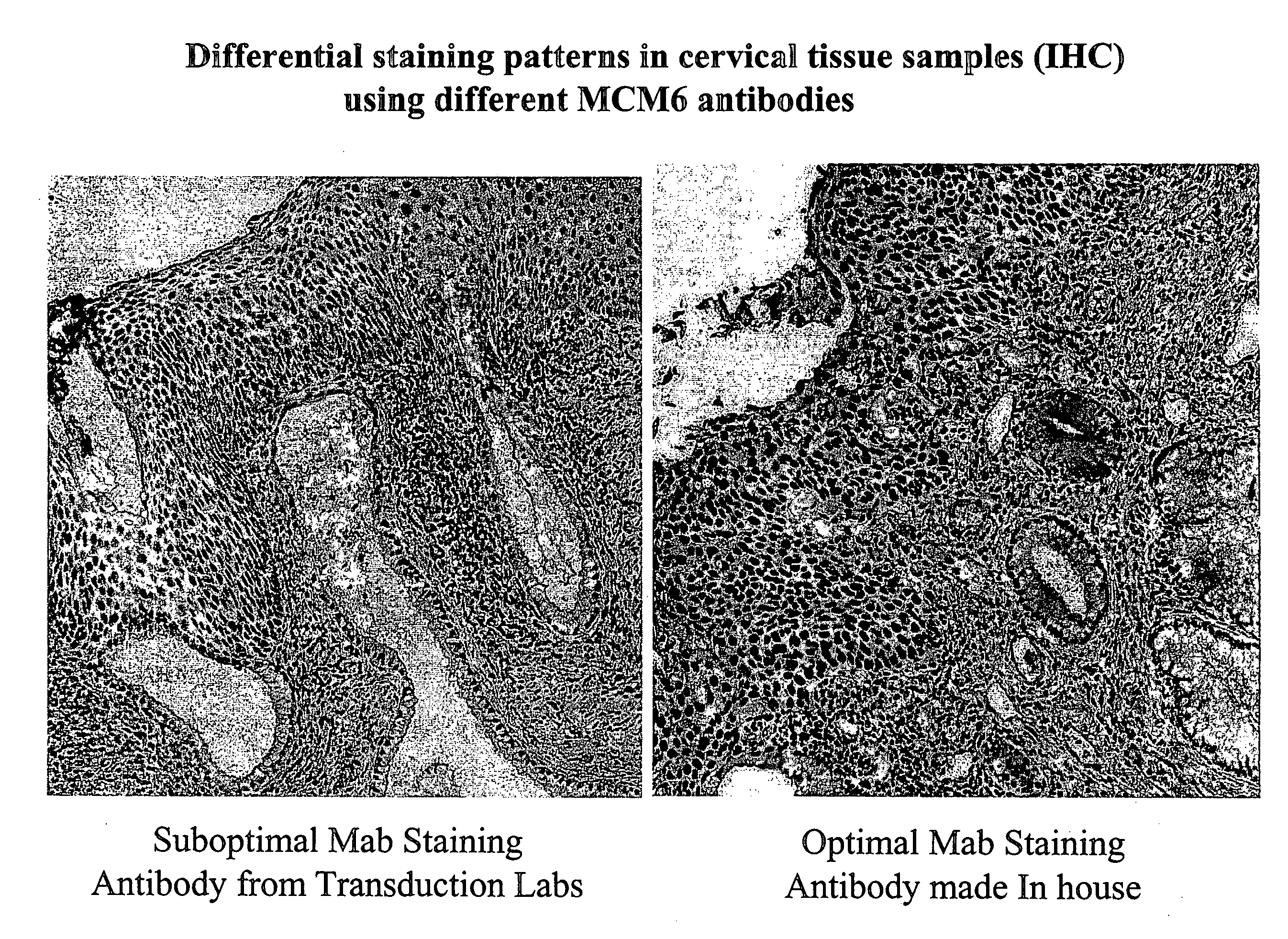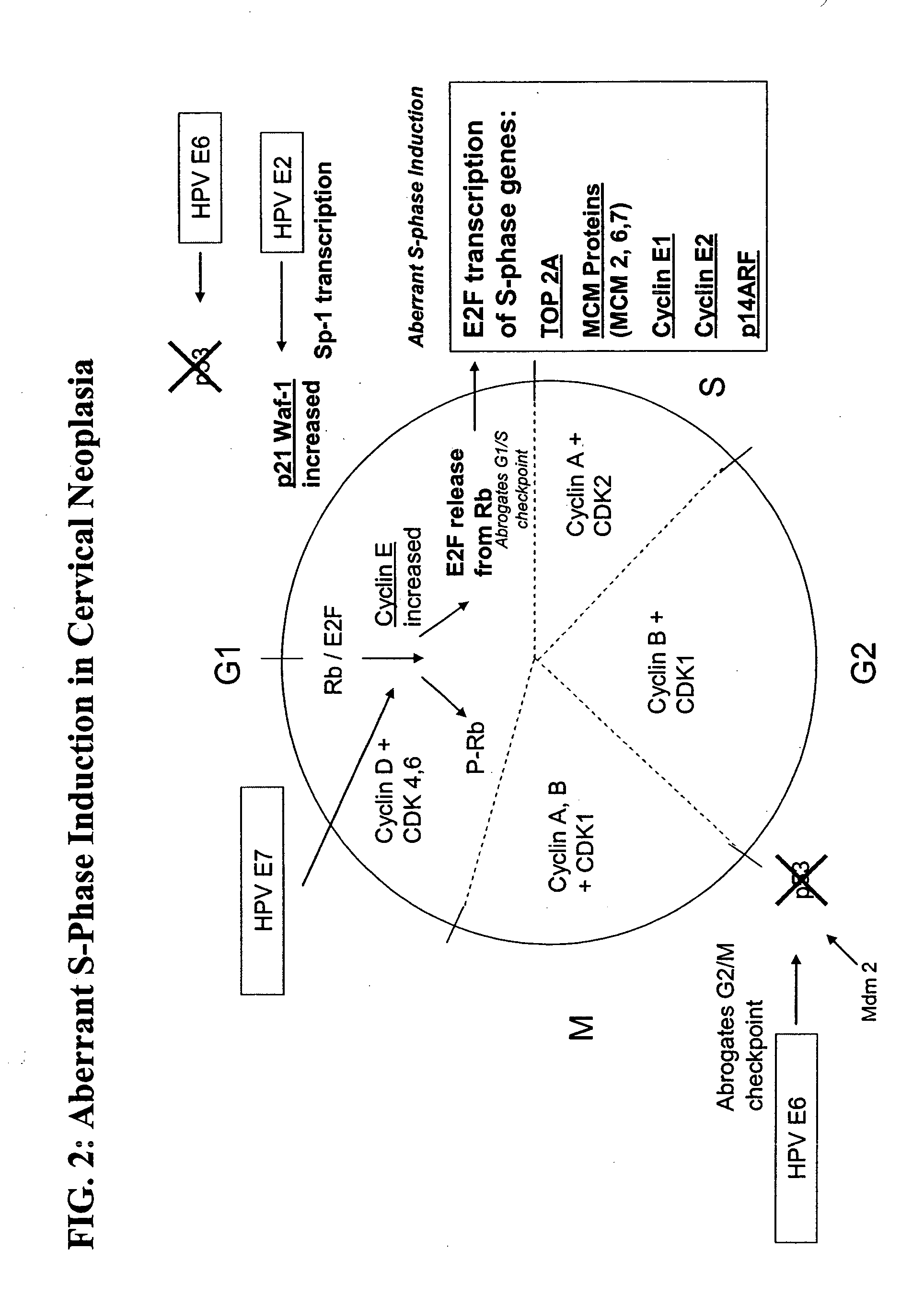Methods and compositions for the detection of cervical disease
a technology of cervical disease and composition, applied in the field of methods and compositions for the detection of high-grade cervical disease, can solve the problems of many false positives, hpv-positive women will ever develop high-grade cervical disease or cancer, and the clinical problem is more serious, so as to accelerate the cell proliferation and increase the level of c-my
- Summary
- Abstract
- Description
- Claims
- Application Information
AI Technical Summary
Benefits of technology
Problems solved by technology
Method used
Image
Examples
example 1
Detection of Biomarker Overexpression Using Immunocytochemistry
Slide Preparation and Pretreatment
[0098] Patient cervical samples are collected and placed into a SurePath™ collection vial (TriPath Imaging, Inc.). Cervical cells are collected from the liquid medium and deposited in a thin layer on a glass slide using the PrepStain™ slide processor system (TriPath Imaging, Inc.). Prepared slides are immediately transferred to a pretreatment buffer (1% RAM) and heated for 45 minutes at 95° C. The slides are cooled to room temperature and rinsed three times (2 minutes per rinse) in TBS (tris buffered saline).
Manual Immunocytochemistry
[0099] To prevent non-specific background staining, slides are not permitted to dry out during the staining procedure. Furthermore, in order to block non-specific staining, hydrogen peroxide is applied to the slides for 5 minutes, followed by a TBS rinse. An antibody directed to MCM6 is applied to the slide for 1 hour at room temperature. Following inc...
example 2
Detection of Biomarkers in Clinical Samples
[0102] Approximately 180 cervical cytology patient samples representing various diagnoses were collected. The presence or absence of cancerous cells or lesions indicative of high-grade disease in these patients was previously confirmed by colposcopy. The following table indicates the number of samples within each diagnosis group analyzed in this study, as well as a description of the colposcopy findings (e.g., presence or absence of high-grade lesions).
TABLE 1Specimens analyzedDiagnosisCountDescriptionNIL72HPV NegativeASC-US2626 without lesion 0 with lesion or high risk HPVLSIL4842 negative for high grade lesion 6 positive for high grade lesionHSIL25Cancer10Squamous Cell Carcinoma andAdenocarcinoma
[0103] The samples were analyzed by immunocytochemistry methods to identify high-grade cervical disease. Antibodies were used to detect the overexpression of six biomarkers of interest: MCM2, MCM6, MCM 7, p21waf1, Cyclin E, and Topo2A. Assay co...
example 3
Detection of Biomarkers in Clinical Samples Using Antibody Cocktails
[0123] Approximately 180 colposcopy-confirmed cervical cytology samples were analyzed by immunocytochemistry methods to identify high-grade cervical disease. Each sample was analyzed for the expression of multiple biomarkers of interest. Specifically, various combinations of antibodies directed to MCM2, MCM6, MCM 7, p21waf1, Cyclin E, and Topo2A were analyzed for their ability to detect high-grade cervical disease. These samples were evaluated for the expression of multiple biomarkers of interest using the immunocytochemistry methods and slide interpretation guidelines described in Example 2.
[0124] The immunocytochemistry results were compared with the results previously obtained by colposcopy. Each slide was then given a final result of true positive (TP), true negative (TN), false positive (FP), false negative (FN), or indeterminate. Sensitivity, specificity, positive predictive values, and negative predictive v...
PUM
| Property | Measurement | Unit |
|---|---|---|
| pH | aaaaa | aaaaa |
| pH | aaaaa | aaaaa |
| temperature | aaaaa | aaaaa |
Abstract
Description
Claims
Application Information
 Login to View More
Login to View More - R&D
- Intellectual Property
- Life Sciences
- Materials
- Tech Scout
- Unparalleled Data Quality
- Higher Quality Content
- 60% Fewer Hallucinations
Browse by: Latest US Patents, China's latest patents, Technical Efficacy Thesaurus, Application Domain, Technology Topic, Popular Technical Reports.
© 2025 PatSnap. All rights reserved.Legal|Privacy policy|Modern Slavery Act Transparency Statement|Sitemap|About US| Contact US: help@patsnap.com



